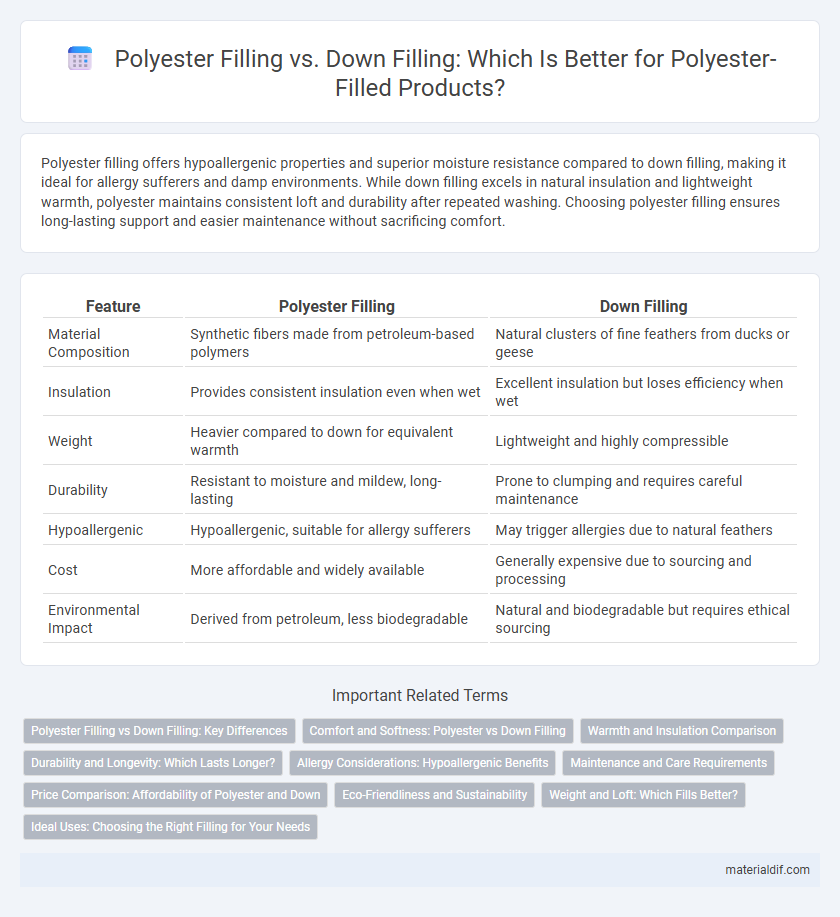Polyester filling offers hypoallergenic properties and superior moisture resistance compared to down filling, making it ideal for allergy sufferers and damp environments. While down filling excels in natural insulation and lightweight warmth, polyester maintains consistent loft and durability after repeated washing. Choosing polyester filling ensures long-lasting support and easier maintenance without sacrificing comfort.
Table of Comparison
| Feature | Polyester Filling | Down Filling |
|---|---|---|
| Material Composition | Synthetic fibers made from petroleum-based polymers | Natural clusters of fine feathers from ducks or geese |
| Insulation | Provides consistent insulation even when wet | Excellent insulation but loses efficiency when wet |
| Weight | Heavier compared to down for equivalent warmth | Lightweight and highly compressible |
| Durability | Resistant to moisture and mildew, long-lasting | Prone to clumping and requires careful maintenance |
| Hypoallergenic | Hypoallergenic, suitable for allergy sufferers | May trigger allergies due to natural feathers |
| Cost | More affordable and widely available | Generally expensive due to sourcing and processing |
| Environmental Impact | Derived from petroleum, less biodegradable | Natural and biodegradable but requires ethical sourcing |
Polyester Filling vs Down Filling: Key Differences
Polyester filling offers hypoallergenic properties, easy maintenance, and affordability compared to down filling, which provides superior insulation and natural breathability. Unlike down, polyester filling retains warmth even when wet and dries quickly, making it ideal for moisture-prone environments. However, down filling excels in compressibility and lightweight warmth, often preferred for high-end bedding and outdoor gear.
Comfort and Softness: Polyester vs Down Filling
Polyester filling offers consistent loft and resilience, maintaining softness and comfort even when damp, making it ideal for hypoallergenic bedding and affordable insulation. Down filling provides superior softness and warmth due to its natural cluster structure, offering exceptional breathability and lightweight comfort essential for cold-weather gear. Choosing between polyester and down filling depends on preferences for allergy sensitivity, moisture management, and temperature regulation for optimal comfort.
Warmth and Insulation Comparison
Polyester filling offers consistent insulation by trapping air within synthetic fibers, providing effective warmth even when damp, unlike down filling which loses loft and insulating properties when wet. Down filling excels in warmth-to-weight ratio due to its natural clusters that create superior air pockets, delivering higher insulation in lightweight garments. However, polyester filling often outperforms down in maintaining thermal properties under moisture exposure, making it preferable for wet conditions or active outdoor use.
Durability and Longevity: Which Lasts Longer?
Polyester filling boasts superior durability and longevity compared to down filling due to its synthetic fibers that resist clumping, moisture absorption, and allergens, making it ideal for long-term use. Down filling, while highly insulating and lightweight, tends to break down faster over time, losing loft and requiring more careful maintenance. The resilience of polyester filling ensures consistent performance through multiple washes and extended usage, often outlasting down in lifespan.
Allergy Considerations: Hypoallergenic Benefits
Polyester filling offers hypoallergenic benefits by resisting common allergens such as dust mites and mold, making it ideal for individuals with allergies or asthma. Down filling, while naturally insulating, can harbor allergens and trigger allergic reactions in sensitive users. Choosing polyester filling reduces the risk of allergic responses due to its synthetic, non-porous structure and easy maintenance.
Maintenance and Care Requirements
Polyester filling is easier to maintain due to its resistance to moisture, mold, and allergens, requiring simple machine washing and quick drying. Down filling demands careful handling, often needing professional cleaning or gentle washing with specialized detergents to preserve loft and prevent clumping. Regular fluffing and proper storage in breathable bags help maintain both materials' performance and longevity.
Price Comparison: Affordability of Polyester and Down
Polyester filling is significantly more affordable than down filling, making it a popular choice for budget-conscious consumers. While down offers superior insulation and lightweight comfort, its higher price point can be prohibitive for many buyers. Polyester provides a cost-effective alternative without sacrificing durability and easy maintenance.
Eco-Friendliness and Sustainability
Polyester filling is often praised for its recyclability and lower environmental impact when produced from recycled PET bottles, reducing plastic waste and resource consumption compared to virgin polyester. Down filling, derived from natural feathers, is biodegradable but raises concerns about animal welfare and resource-intensive farming practices, which can affect its sustainability. Choosing recycled polyester filling supports circular economy principles, making it a more eco-friendly option in sustainable textile production.
Weight and Loft: Which Fills Better?
Polyester filling offers a lightweight and hypoallergenic option with moderate loft, maintaining consistent loft over time without significant compression. Down filling provides superior loft due to its natural clusters that trap more air, resulting in higher insulation and a fluffier feel, but it is heavier and may compress more easily under pressure. For maximizing warmth-to-weight ratio, down filling fills better, while polyester filling is preferred for affordable, low-maintenance, and allergy-friendly cushioning.
Ideal Uses: Choosing the Right Filling for Your Needs
Polyester filling offers excellent durability, hypoallergenic properties, and easy maintenance, making it ideal for outdoor gear, budget-friendly bedding, and children's products. Down filling provides superior insulation, lightweight comfort, and natural breathability, perfect for high-performance winter wear and luxury bedding. Selecting the right filling depends on prioritizing durability and affordability with polyester or seeking warmth and softness with down.
Polyester Filling vs Down Filling Infographic

 materialdif.com
materialdif.com